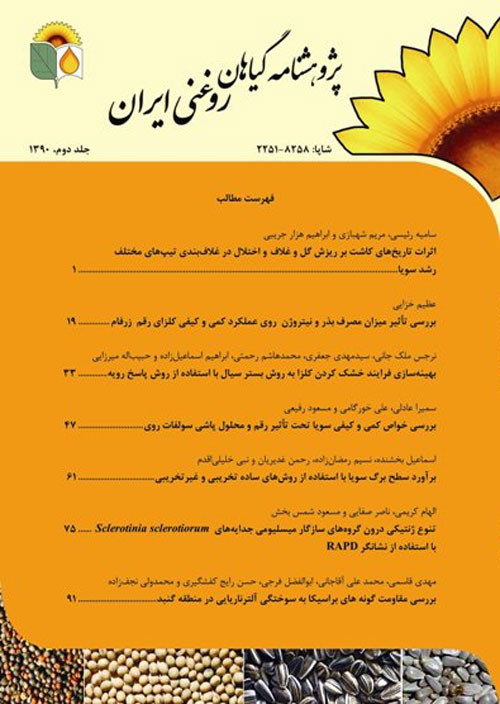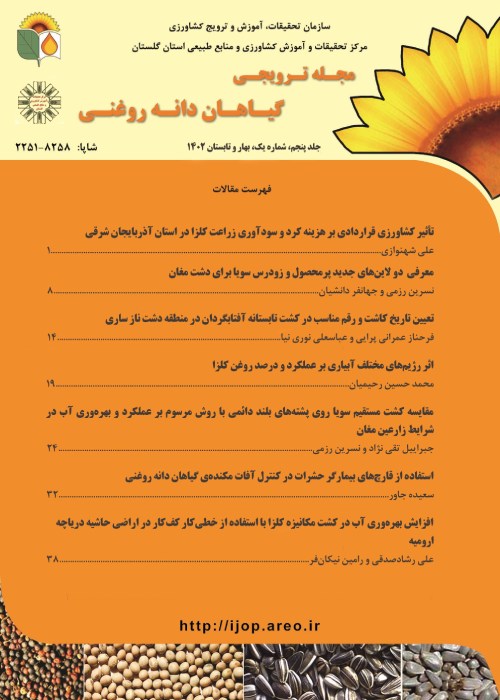فهرست مطالب

نشریه گیاهان دانه روغنی
شماره 2 (1390)
- تاریخ انتشار: 1390/11/18
- تعداد عناوین: 7
-
Page 1Soybean podding disorder, in different forms as low fertility to lack of fertility, causes high damage to soybean fields in some years in Golestan province. Since it was likely that various varieties respond differently for podding disorder and that planting dates might affect it., three varieties, Williams; early-maturing with indeterminate growth habitat, Sahar; mid-maturing with semi-determinate growth habit and Gorgan 3 late-maturiting with determinate growth habit evaluated at seven planting dates from 5th of May with interval of 13 days. This study was done in a factorial experiment based on a randomized complete block design with three replications in two years 2002-2003. In the first year, Gorgan 3 variety produced the highest grain yield at the first planting date, but because of podding disorder incidence it stayed in early reproductive growth stage from the third planting date onwards. Sahar and Williams varieties produced an acceptable yield until the fourth and fifth planting dates, respectively. In the second year, the yield decreased with a delay in planting date, and podding disorder was observed only for Gorgan 3 variety at the last planting date. Sahar variety produced the highest grain yield at the first planting date whereas Gorgan 3 produced the lowest yield at the last planting date with, 2511 and 249 kg/ha, respectively. The production and shedding of flowers and pods showed that the number of flower was the highest at the first planting date. Flower shedding increased until the fourth planting date and then it decreased. With a delay in planting, flowering and podding in Williams had lower variation but Gorgan 3 had higher shedding rate than other two varieties. In late plantings, pollen germination ability showed a considerable decrease in Gorgan 3, too. The leaf photosynthetic efficiency decreased in all of the varieties due to delay in planting. The results of this study showed that to decrease the damage to soybean grain yield caused by podding disorder, we could use suitable varieties with semi-determinate or indeterminate growth habit.Keywords: Soybean (Glycine max L.), Planting date, Temperature, Flower shedding, Podding disorder
-
Page 19In order to investigate the effect and sufficientcy of nitrogen and seed rate on yield of seed and oil and yield component of rapeseed cultivar Zarfam, a field experiment was conducted in a factorial based on randomized complete design with three replications in agricultural and natural resources research center of Lorestan province, Iran during 2004-2006(In irrigation conditions). In this experiment five urea levels of 0.5R, 0.75R, 1.25R and 1.5R (R=recommended rate of 285 kg/ha) were assigned to main plots and four seeding rates (6, 8, 10 and 12 kg/ha) were assigned to subplots. Analysis pooled over the year of experiment showed that grain yield was not significantly different among nitrogen levels. The result, also, showed that the effect of none of seeding rates was significant. Interaction effect of nitrogen level of 1.5R and seeding rate of 8kg/ha significantly had the highest seed yield of 4686.5 kg/ha.The number of silique per plant and plant height showed significantly positive correlation with grain yield Oil percentage had significant positive correlation only with 1000 grain weight. between grain yield and oil percent was significant negative correlation. It is concluded that nitrogen level of 0.5R and seeding rate 6-8 kg/ha is suitable for the area under study.Keywords: Rapeseed, Nitrogen levels, Seed rate, Grain yield
-
Page 47This experiment was done during 2009 in Islamic Azad University research Farm in Khoramabad to study the effects of zinc sulphate solution spray on the yield and yield components of three varieties of soybean. Factorial arrangement was used on the basis of randomized complete block design with four replications. The three varieties were: V1= m7, V2=m9, V3=L17 and three level of Zinc Sulfate (0, 0.002, and 0.004 kg/L) were applied at flowering and podding stages. The characteristics under study in this research were: the number of sub branch, the number of pod per plant, thousand seed weight, biological yield, seed yield, seed oil and protein percentage. The result showed that zinc sulfate levels did not have any significant effect on seed yield and biological yield. The highest seed yield (2130.9 kg /ha) was obtained from L17.The interaction of zinc sulphate solution spray and variety was only significant on protein and seed oil percentage (p<0.01). A significant but negative correlation was observed between seed oil percentage with seed protein percentage (r=-0.725**).The number of pod per plant was affected by zinc sulphate. The effect of levels of zinc sulphate and variety was notsignificant on 1000 seed weight. The number of sub branch was significantly affected by variety (P<0.01).Keywords: Foliar application, Soybean, Zinc Sulphate, Yield
-
Page 61
Accurate measurement of leaf area (LA) is very important for agronomic and physiological studies. Since there was little information available for estimation of soybean (Glycine max L.) leaf area, a two-year investigation was carried out to develop models for predicting plant leaf area, by measuring the length (L) and width (W) of terminal leaflet of each leaf, green leaf dry matter (GLDM) and the total number of green leaflets per plant (TNLP) in soybean plant (Catol, Sahar, Williams and Hill cultivars) at the Gorgan University of Agricultural Sciences and Natural Resources in 2008-9 and 2009-10 growing season. Experimental design in both years was a randomized complete block design with four replications. The regression model was fitted for each cultivar in each year, separately, and the prediction different regression equation was evaluated. Results indicated that the ΣLW-based models were better (highest R2, smallest RMSE and CV) than models that used only ΣL and ΣW as independent variables for calculating soybean leaf area. We concluded that the linear model [Total leaf area=6.876 + 1.813 ΣLW (sum of product of L and W per plant), R2=0.99] should be used for nondestructive leaf area estimation, and Total leaf area=298.47+136.54 GLDM (R2=0.79) should be used for destructive leaf area estimationEvaluation of these equations indicated the good accuracy of these equations for the estimation of soybean leaf area. When leaf area meters are not available, these equations should be used as a simple, fast, accurate and reliable method for estimation of soybean leaf area.
Keywords: Leaf dimension, Number of leaflets, Soybean, Regression models, Green leaf dry weight -
Page 75Genetic diversity of Sclerotinia sclerotiorum isolates collected from canola fields of Golestan, West Azarbaijan and Mazandaran states were investigated by RAPD molecular marker. All collected isolates were identified as S. sclerotiorum using nested-PCR technique which amplified a single band of 278 bp. Twentyseven isolates belonging to 12 mycelial compatibility groups were selected. The RAPD profiles amplified by nine primers out of twenty-nine random primers were polymorphic and reproducible. These primers identified 216 loci which 214 loci were polymorphic. The discriminatory power of OPB04 was highest (D = 0.997) compared to other primers, indicating its high ability for assessing genetic diversity among MCGs. Cluster analysis of data resulted from nine primers showed that in most cases isolates belonged to one MCG was not categorized into the same group, indicating high genetic diversity within studied MCGs. Each eleven MCGs were associated with more than one haplotypes whereas only the members of one MCG shared the same DNA fingerprint. This result suggests that new genotypes areevolving in northern regions of Iran.Keywords: Sclerotinia sclerotiorum, Canola, Simpson index, MCG, RAPD. Iranian Journal of Oil Plants
-
Page 91Alternaria blight causes severedamage to oil producing Brassica spp. in many parts of the world, so the quality and quantity of its oil is reduced. This research was performed in fall of 2010 to investigate the resistance of Brassica species to alternaria blight, including two genotypes of mustard (j-98-102/51 and Bard-1), two genotypes of oil turnip (Candle and Rainbow), three genotypes of canola (Hayola 401, Shiralee and RGS003) and an F4 generation (fourth generation of rapeseed-mustard cross). The experiment was performed as a randomized complete block design with three replications at the agricultural research station of Gonbad, Iran. For this purpose, the incidence (I) and severity (S) of disease were measured at definite time intervals from the appearance of the symptoms to harvesting time and based on these data, disease progress curves (DPCs) of epidemics were drawn. Using DPCs, AUDPC and rAUDPC were calculated. Analysis of variance showed that there were significant differences (P<0.01) between genotypes for these variables. Data mean comparison showed that genotype Candle was the most susceptible, Bard-1 and Select4 were susceptible and J-98, RGS003, Rainbow, Shiralee and Hayola 401 showed less susceptibility to Alternaria blight, respectively.Keywords: Brassica spp, Alternaria blight, field resistance


